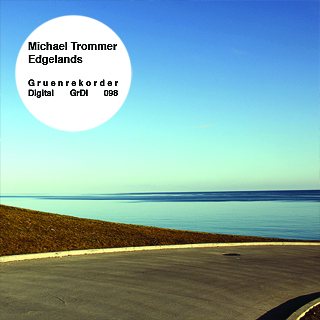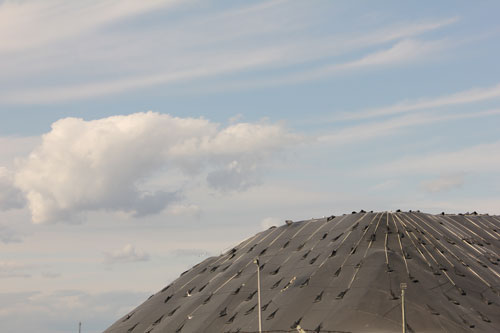
Edgelands | Michael Trommer
GrDl 098| Gruen Digital > [order]
MP3 & FLAC
the pieces that comprise ‚edgelands‘ are composed of field recordings made in the liminal spaces which exist between the built and natural environments – suburban developments, factories and power stations, urban environments in states of disuse and decay, urban shorelines well as city and ex-urban parks.
MP3
01 bob lake hydro-electric 11:55
02 bobcaygeon deepfield 10:22
MP3
03 cityhum 8:44
04 edgelands 2 11:20
05 factory A2 8:24
06 ghostwood 7:04
MP3
07 guildwood 9:44
7 Tracks (67′32″)
as the material makes extensive use of infra- and ultrasonic frequencies, headphones or a subwoofer are recommended.
Field Recording Series by Gruenrekorder
Gruenrekorder / Germany / 2012 / GrDl 098 / LC 09488
Caity Kerr | The Field Reporter
Michael Trommer is a Toronto based producer and sound artist whose experimental work focuses primarily on psychogeographical explorations via the use of field recordings.
The sleeve notes tell us that ‘the pieces that comprise edgelands are composed of field recordings made in the liminal spaces which exist between the built and natural environments – suburban developments, factories and power stations, urban environments in states of disuse and decay, urban shorelines well as city and ex-urban park’.
Because of the infra- and ultrasonic frequencies listening with headphones or a subwoofer recommended
1. bob lake hydro-electric [11:55]
Trommer has crafted something approaching a signature sound across all the tracks of this album – a heavy duty low frequency presence and a contrasting high frequency hiss, both of which might have been electronically generated, though given the information in the sleeve notes, it’s more likely that he’s remove the midrange from various field recordings and used the results as a primary layer in his compositions. This simple technique, taking out the midrange, still strikes me as very much from the elektronische tradition.
As with many works in this style, where a relatively static layer is set up, we wait expectantly for the change, the extra material. I’m interested in why we should do this and ultimately in how the composer negotiates these expectations? I always want to find out why and at which point the artist decides he’s had enough and what would be the difference between one piece of pure stasis and a whole album of almost similar material but the album as a whole doesn’t embark upon this experiment. Instead I get a sense of very clear, concise and deliberate choices, high production values and some inexplicable choices of material.
Back to the sounds, a lot of the time we find ourselves on the delicious cusp between field recordings and electronic oscillators. On the other hand, the reverbed tails don’t do the music any favours, speaking to me of techniques of production rather than engagement with the materiality of the sources. But each to their own. There is much to be appreciated in the polish of the production, if that’s your thing, in the extreme filtering, in the abstracted, stark and austere mood of many of the pieces. This first track left my ears muffled, something I haven’t had done to me for ages.
2. bobcaygeon deepfield [10:22]
Here we have the same bass presence, a lighter touch on the highs and hisses, and this time the presence of the artist or at least some manner of human agency and a sense of place. The range of sounds is richer: watery sounds, interventions, some ‘high lonesome’ birdy sounds. Then raindrops, or rather the quality of the surface on which they fall, helping us to map out the topography.
The pattern is established – a background layer or ground in the form of an (almost) ostinato bass with high frequency presence over which events take place: biophonies and geophonies, all establishing the sense of location by means of small repeated details. Although there is a sense of the literary in the mystery and uncertainty, this is a descriptive rather than a narrative approach, encouraging the mind to paint its own picture from the sound.
3. cityhum [8:44]
Again the same bass and hiss with filtered ambience and traffic-like envelopes, all very well presented. What sounds like a more industrial interior space opens up, with possible machinery. I’d use the usual cliché about it being Tarkovsky-esque, but this is a bigger space and more diffuse than the ‘Stalker’ setting. The sound eventually levels out into a broadband polyphony. Again the reverbed and digitally delayed ending breaks the spell, smacking of over-production and taking me into the studio, where I don’t really want to be.
4. edgelands 2 [11:20]
Hiss, buzz, then a bassy machine sound with birds on top. Various shavers (haircut memories) dance around the mix like alien spacecraft. Again the sawtooth-like waveforms make this is a very electronic sound world. At times I had the impression of a big foregrounded complex machine with activity at all levels of the frequency spectrum, There’s still some ‘fieldy’ stuff going on around it, bloops and plops, which ‘grounds’ the piece well, but it risks straying into alien abduction territory or at least a carefully composed dystopic/filmic domain.
The piece then moves into a very interesting texture broken by a periodic metallic clinky sound, then unexpectedly goes into self-initiated meltdown with the entrance of a spangling of fifth and octave runs from a synthy instrument. I wondered at first if there might be a hidden agenda here that the piece was commissioned for film. Whatever the case the synth sticks out like a dog’s bollocks.
5. factory A2 [8:24]
This track has the same ambivalence as the last – hiss and bass, rapid intrusions and activities, consistent with the sound world of all the tracks, then a hint of resonance with periodic enveloped whooshes hint at urban post-dance production values. The producer takes over, a fact made more transparent in the digital delays at the end. For some this will be an interesting dynamic – two levels of the artist’s presence, in the field and in the studio, made very obvious in contrasting ways. I simply hear delay and reverb, both of which strike me as unnecessary given the successful treatment of the core sounds.
6. ghostwood [7:04]
This is another of the more filmic tracks – a burbly watery beginning, the grain and gristle of field recordings, cars (?). Then for long spells we return to the heavy duty low frequency rumble with no midrange. The filmic ambience reappears with wind and reception interference, various activities in the background, ghostly birds, voices in the radio spectrum. The structure of the piece offers us a pleasing arch form.
7. guildwood [9:44]
Here there are some notable compositional strengths: a disjunction of spaces and a great depth of field which offsets the frontal/central clicks. Add to this a hint of crescendo with the addition of material, then a decrescendo by taking away from the texture. Again, some very obvious processing, though the gentleness of this piece is more forgiving.
Overall, I’d concur with the advice to listen over a good playback system to fully appreciate the work.
Released as part of the Field Recording Series by Gruenrekorder
Axel Ganz | Jahrgangsgeräusche
Die Welt wird zum Versuchslabor. Dabei scheinen die Randgebiete städtischer Agglomerationen alles zu bieten, was man für einen im besten Sinne offenen Experimentierbaukasten braucht. So, oder so ähnlich könnte sich die akustische Situation in den kulturellen Übergangszonen für den in Toronto lebenden Klangkünstler Michael Trommer dargestellt haben, als er begann die Außenbezirke städtischer Großräume auf ihre akustischen Eigenschaften hin zu untersuchen. Mit all ihren Fabriken, Kraftwerken und Brachen, mit ihren Ausdehnungsprozessen und Niedergängen stellen sie gerade auch als Lautsphären Übergangszonen zu benachbarten Strukturen dar, ein bisher weitgehend unerforschtes Terrain.
Dabei scheint Trommer, der schon an zahlreichen Orten Audio-Installationen aufbaute, nicht den puristischen Phänomenologen zu geben. Im Gegenteil, er experimentiert ebenso mit den Positionen der Mikrofone, wie er mit seinen untersuchten Objekten manchmal zu spielen scheint. So kommt er, zu erstaunlich kleinteiligen, ja manchmal fast kargen Ergebnissen. Zwar schichtet sich oft in kurzen dichten Momenten Wiedersprüchliches übereinander, doch kommt es nicht zu spektakulären Konfrontationen von klanglichen Gegensätzen. Oft vermisst man sogar die Abbildung räumlicher Tiefe durch gewohnte Staffelungen von Geräuschen, da sich bei Trommer vieles prominent im Nahbereich abspielt.
An manchen Stellen verliert man sogar das Gefühl für den akustischen Außenraum. Jedoch, das muss nicht enttäuschen. Im Gegenteil, das ist die eigentliche und überraschende Erkenntnis: Die Welt wird zum Versuchslabor. Bei Michael Trommel scheint sie sich selbst einzustülpen in einen imaginären Raum voller neuer Möglichkeiten. Ein erstaunlicher Prozess, der sich allerdings nur demjenigen erschließt, der nicht nach dem spektakulären Momentum sucht.


